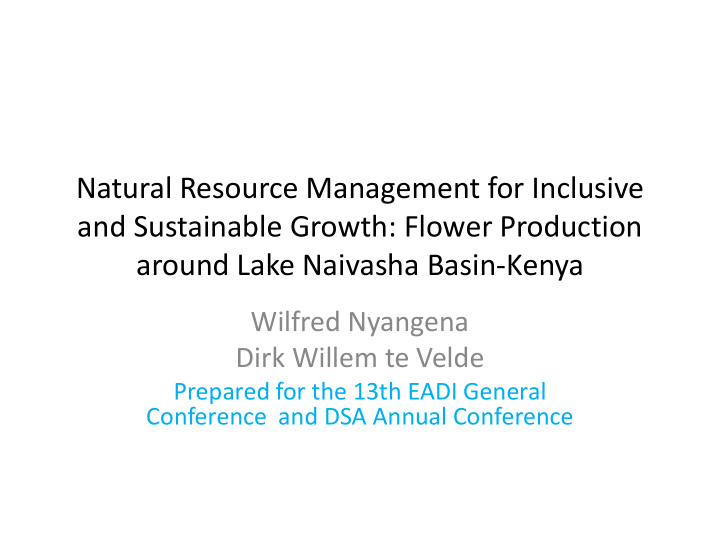



Natural Resource Management for Inclusive and Sustainable Growth: Flower Production around Lake Naivasha Basin-Kenya Wilfred Nyangena Dirk Willem te Velde Prepared for the 13th EADI General Conference and DSA Annual Conference
Introduction • Lake Naivasha basin and the WEL nexus • Natural resource management and inclusive sustainable growth • The importance of coordination in WEL nexus for ISG- LakeNaivasha Basin
I.Why Lake Naivasha Basin? • Lake Naivasha Basin (LNB) provides the basis for a number of economic activities-agriculture, tourism, energy production and flower production. • Basin currently generates about 10% of forex to Kenya. Produces a fifth of all roses on the EU market. • Close to 2 million Kenyans derive their livelihoods from the basin. • Incomes are relatively higher than rest of the country. • YET there are considerable environmental pressures due to land use change and behaviour of upstream users and the success of the sector hence attracting many.
Why LNB cont’d The future of one very successful and rapidly emerging industry in • Africa is critically dependent on the management of a small river basin. A complex situation of different users from different locations in • different sectors. -Land use changes upstream affects availability and quality of water downstream. -The production of geothermal energy downstream requires water and affects land use. -Flower farms downstream withdraw water and require energy services. -Tourism critically depends on quality water resources. - This is a perfect example of how Water-Energy-Land resources are increasingly interrelated and affect each other. _ The WEL nexus.
Forest cover changes: 1973 and 2008
Who are the Players? • Small scale farmers upstream and flower farmers downstream affect water quality and availability. • Renewable energy production requires land and water. • Pastoralists require land and water for their livestock. • Tourism sector requires quality water.
Players cont’d • Deforestation in the upper catchment. Extreme floods during rainy season and low volumes in drought. • Sub division of land owing to population pressure. • Increased sediment load circa 7 million tons into the lake. • Heavy metal contamination from pesticides. • Destruction of papyrus leading to loss of filtering functions. • Lost flood control capacity and fish breeding grounds.
II.NRM & ISG-Role of business and their associations • Business association have responded to the environmental challenges posed by a deteriorating quality of lake Naivasha basin. • Flower companies-most visible though there are other institutions. • Declining profits and the desire to remain competitive internationally has raised issues of sustainability among the players. • Examples:
Examples Finlays ( Formerly Flamingo flowers) • Invested millions of pounds in water recycling, rainwater harvesting to reduce water use by flowers. • Reduced pesticide use especially the toxic class 1 chemicals. Now use biological control e.g ladybirds and other predators. • Adherence to labour laws, ethical trade initiative (ETI) • Established tree nurseries and initiated tree planting to replenish deforested lands. • All flower production and processing now follows the Fairtrade standards and several other audits. • The Kenya flower Council has also introduced the Gold standard.
Examples cont’d Oserian Flowers • Flower farm has invested in clean energy provision by sinking a well to tap geothermal energy for flower production. (no chemicals, water recycled etc) • To improve the carbon footprint flowers transported by sea etc. • Ecological farming practices eg use of red worms, biological pest control etc.
III.Business associations Kenya Flower Council (KfC)and Fresh Produce Export Association (FPEAK) • Bringing stakeholders and taking leader role to host Kenya flower days to their customers in the EU to display their ”clean” flower production methods. • Developed a code of practice based on Global Good Agriculture Practices (GAP). • Established standards and conducts regular audits to ensure adherence by members. • By being compliant to the code of practice the companies have promoted inclusive and sustainable growth.
Other local initiatives Lake Naivasha Water Resources Users Association (LANAWRUA) • Lake Naivasha Riparian Association (LNRA) established in 1929 to protect local landowner’s rights. • With the advent of the flower industry the association has tried to balance the impact of expanding commercial interests and protecting the environmental integrity of the lake. • Lake Naivasha Growers Group (LNGG) and Lake Naivasha Riparian Association (LNRA) formed in response to the declining ecosystem. • They have developed a comprehensive management plan to control human activity in the basin.
Government • Ministry of Environment and Mineral Resources started piecemeal actions to save the lake.(Water harvesting,restoration of dams etc.) • Prime Minister’s office with Prince Charles last July started the ”Imarisha Naivasha” initiative to restore the ecology of the basin.
International Actors • UNDP, CARE &WWF – PES scheme for upstream farmers. Coasian approach where downstream users will pay/ ”bribe” those upstream not to pollute and over abstract the water. • IPM support for universities and local laboratories. • The KfC in collaboration with international labs such SGS, De Haan Labs of Netherlands etc.
Conclusion • A perfect example of how water-energy-land interact- WEL nexus. • Various initiatives are on by local government and institutions, small scale agricultural users etc on how to improve the management of the basin. • BUT more is needed: -water stewardship -PES (payment for ecological services) -Promotion of public-private dialogue -enhancement of water use efficiency by flower farms -enhance water resource management -Assistance in coordinating the emerging actors and their initiatives
Recommend
More recommend